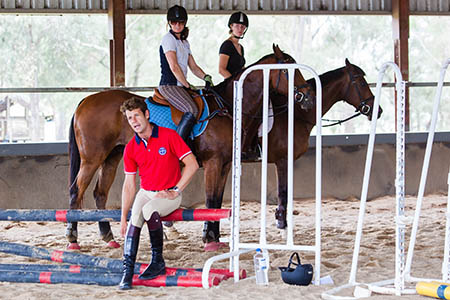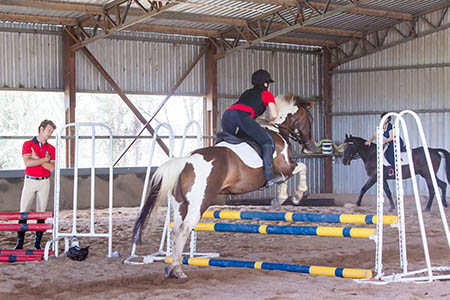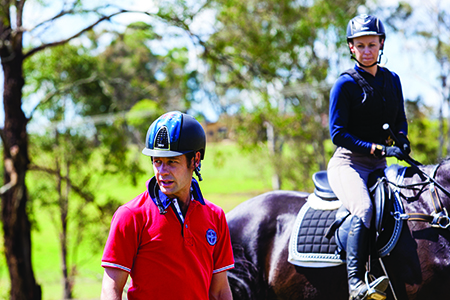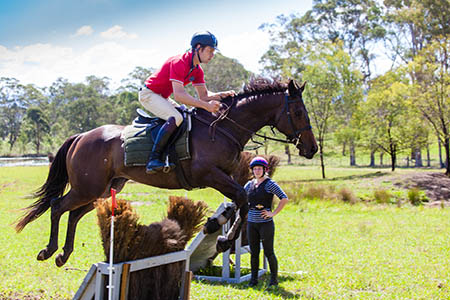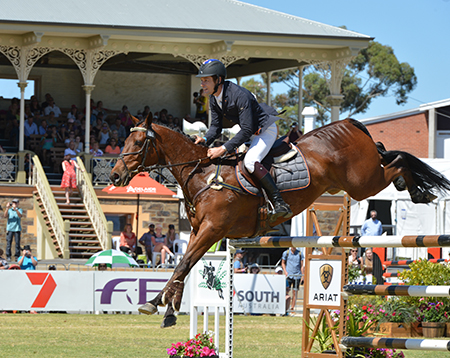 Winning the 2013 Adelaide Four-Star on TS Jamaimo, who was to become Chris’ horse for Normandy. Unfortunately their WEG campaign was cut short when Jamaimo developed a colic the night before the cross country.
Winning the 2013 Adelaide Four-Star on TS Jamaimo, who was to become Chris’ horse for Normandy. Unfortunately their WEG campaign was cut short when Jamaimo developed a colic the night before the cross country.
Rebecca Ashton sat in on this lesson with Christopher and took the photos…
Christopher Burton was fresh from his surprise win at the 2013 Adelaide 4 Star when I found him giving a clinic at Christine Bates’ wonderful complex Willow Park at Wilberforce. Unfortunately, due to ridiculous amounts of rain the week before, most of the sessions at the Northside Riding Club clinic were confined to the 20 x 60 m indoor. This didn’t stop Chris working on the basics and the lack of space actually made for more precise riding.
All sessions began with Chris checking the flat work was under control and the horses were responsive to the stop/go aids. For all those eventers who find the dressage training a drag (which is probably most!), Chris was adamant of its importance, “Dressage is designed to help us have control of our horses so we can jump them.”
He wanted the horses to respond off the voice, ‘whoa’ to stop and a ‘cluck’ to go, but supported with leg and hand to begin with. When Caitlin Foulis’ green stallion wasn’t responding to the forward aids enough, Chris encouraged.
“Say ‘cluck’ followed straight away with the leg. When you kick him Caitlin, something has to happen. He has to fart and bolt! That’s what’s so good about living in Australia. We live on an island; the horse can’t go anywhere! In a dressage test, when I do an extended trot, I don’t use my leg. I cluck just so the horse can hear, then he goes because he knows in the past that it was followed by a kick.”
When Debbi Jenkin’s horse wasn’t responding well enough to the stop aids, Chris wanted her to understand how very important this was before they could move on.
“Say whoa first and then use the reins to stop until we don’t have to use the reins anymore,” instructed the Olympian. “If you can’t halt, you can’t half halt. If you can’t half halt, you shouldn’t be pointing a horse at a jump.”
He really wanted his students to become riders that remained centered, rode without using the reins, and allowed the horse to just get on with the job. “The more you give, the softer he will be. You need the hind legs under more,” reminded Burton.
The flat work also gave Chris a chance to check on the riders’ positions. Some riders wanted to flap and use their whole body to get the horse to respond, sledge hammer style, and Chris was quick to get them still and using the smallest aids possible. It’s easy to form bad habits, so awareness is key.
With stop and go under control and horses working over their backs, it was time to put it into practice over some poles. With two poles set some meters apart, Chris wanted the riders to canter between them. “You have to get the poles within the canter stride. No matter if you have to lengthen or shorten, it has to be in the stride,” he instructed. After the riders cantered over them a couple of times, the question was put to them; “How many strides did you have in between?” There were some blank faces with the trainer emphasising that ninety percent of riders forget to count. “I always count!”
The natural stride between the two poles was five, and the riders had to estimate the canter they would need to achieve this before they even started the exercise. Once the horses were balanced and happy with this, the challenge was to make the distance in six and then seven strides or stretched right out to just four, then three strides.
more below
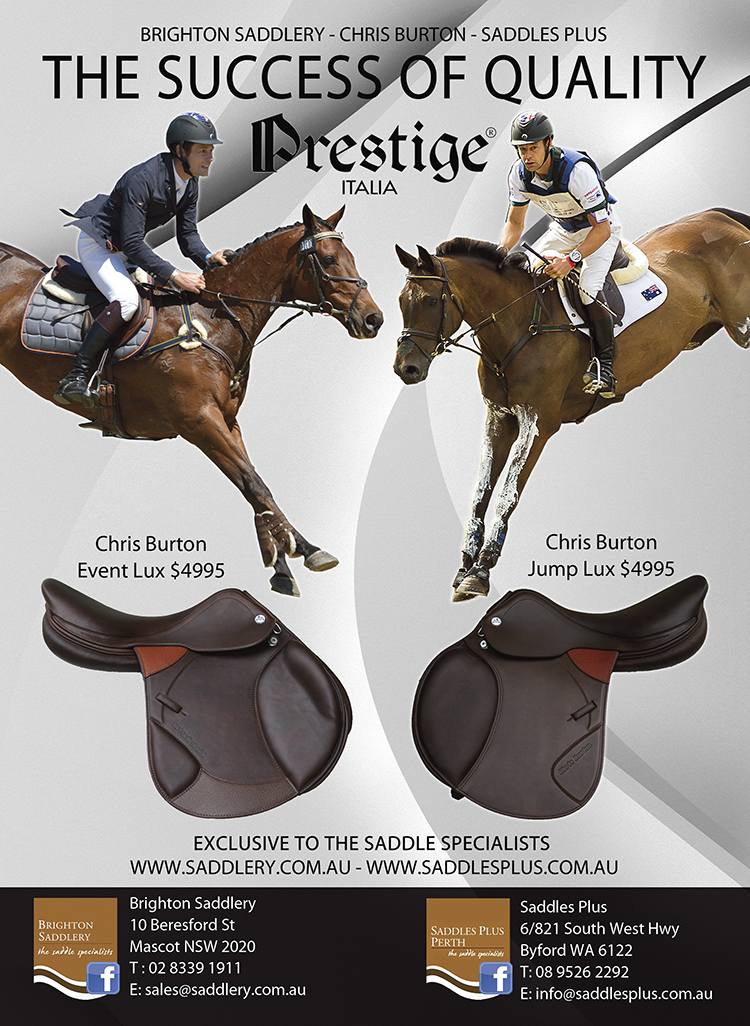
When Rachel Temms was asked to do seven strides in between she asked, “Am I allowed to curve?”
“No! It’s a centreline. This is a dressage arena. That would be cheating! Clever girl, though,” joked Chris.
Rachel needn’t have worried as she executed it without faults. Chris was impressed. “Nice canter! See? You have choices. Good, hey? Now you’ve got your horse listening to you.”
There were no excuses not to do this exercise. “You can do this anywhere,” encouraged Chris. “Go buy two poles from Bunnings. You need to be able to control your horse like this. The counting will help you see the distance and that will help the horse to jump. Until you’re Marcus Ehning, it’s best to practice like this. You have to understand what this exercise is about. You might get it after 10,000 hours of practice!”
The exercise was progressed to the poles becoming cross rails, then verticals, and then the second fence became an oxer. Ali Pettit’s grey horse impressed Chris with its jumping ability as the second jump kept going up higher and higher. “If your horse has ability, if you get your take off right, the jump can be as high as you like. The distance stays the same but the jump can go up,” he said.
The question was posed, if this had been in a competition, which number of strides a rider should aim for. Burto responded, “Do the 10,000 hours of practice and you’ll know which to do, but the horse always has to react off the lower leg.”
Chris isn’t an instructor to sit in the corner offering the odd ‘good’ to the rider. He’s hands on and sees the benefit of getting on the horse and giving the rider a visual if they are really struggling with the concept or exercise. When Debbi was struggling with the speed control Chris brought her into the centre. “Some people learn better by feeling and doing, some by watching. Bring him here and I’ll do a demonstration.” One horse per session had the star rider on board. He really worked on getting the horses straight, balanced and not anticipating the jumps. Chris soon had Debbi’s horse flying but also stopping on a dime.
Lines were next to being tested with two jumps diagonally placed on a straight line. Chris stood on the line at the opposite end so the riders had something to focus on. With the jumps on an angle, it was tempting for the riders to lose the straightness. “Look up!” encouraged Chris. “You have to keep your eyes up and look at me.”
Last was a little, tight course of five jumps to put it all into practice with about ten meters at the end to land and halt. Gabbi Sanderson on her palomino did a great job of it and Chris explained why.“All the jumps were just there waiting for you. The exercise we did at the start helped you with that.”
Again Chris emphasised the rider’s role of getting the horse to the jump but not doing the jumping for them. “We’re on their back. We can’t make them jump. Pulling on their mouth doesn’t make them jump better. It makes them jump worse.”
When Claire Earle was encouraging her horse a little too much with her spur, she had to get rid of them. “You don’t see your distance so then you kick him with the spurs at the last minute,” Chris explained. “It upsets his rhythm and he knocks the jump.” A still leg with the horse sharp to the aids had the problem cured.
By the end of the day, the ground had dried out enough for the last group to take on a few cross country jumps. Of the four riders, three had a racing background, with Kathy O’Hara a Group One winner. First was the essential flat work with big, flowing lines to establish the forwardness before the speed control was checked.
Then it was over some small jumps. Chris seemed to like what he saw. “It’s nice to teach such balanced riders. It’s not so scary to watch!”
But even then he had to warn them about letting the horses be too relaxed. “Kathy, I like how you lob around a bit, but if you’re going to scare him, that’s how you do it. Just get him up into your hand a bit more. If you have their blood up a bit, without frying their brain, they’ll jump no matter what.”
The group moved onto some downhill jumps and Chris reminded the riders to leave their horses’ heads alone and to just let them jump. “Our job, like in track work, is to settle them on course. Let them think for themselves a bit.”
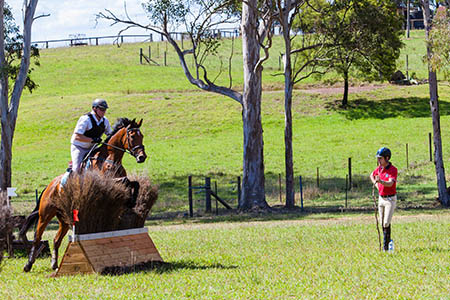 A corner was commented on as Chris passed it on the way to some brush jumps. “It’s an oxer really. Don’t over think it.” Burto was happy to leave the flags up on the brush jumps as it helps the horses jump straight. When Jo Saville’s horse refused the jump twice and popped her off, Chris was quick to jump in the saddle. He trotted the horse up to the fence and halted him while explaining; “We’re halting him because he’s not listening to your left/right rein. We know he has a big jump.” Once the horse understood that he couldn’t escape, Chris cruised over a few times to get the horse’s confidence before Jo jumped back on.
A corner was commented on as Chris passed it on the way to some brush jumps. “It’s an oxer really. Don’t over think it.” Burto was happy to leave the flags up on the brush jumps as it helps the horses jump straight. When Jo Saville’s horse refused the jump twice and popped her off, Chris was quick to jump in the saddle. He trotted the horse up to the fence and halted him while explaining; “We’re halting him because he’s not listening to your left/right rein. We know he has a big jump.” Once the horse understood that he couldn’t escape, Chris cruised over a few times to get the horse’s confidence before Jo jumped back on.
Burto was obviously impressed with Kathy’s riding and also her black gelding over the brushes. “Good! You helped him with the power and the distance. You never want to come quietly to a cross country fence!”
Chris Burton proved to be a focused instructor, generous with his advice and determined to bring the best out of each student. Correct strides and good lines were the order of the day as well as the horse being reactive and sharp to the rider’s aids. Someone, who has won Aachen a couple of times, taken out Saumur and can win a 4 Star event on a horse that has never competed at that level before after just a couple of rides is well worth listening to, as I’m sure all the riders who took part in the clinics would agree.



